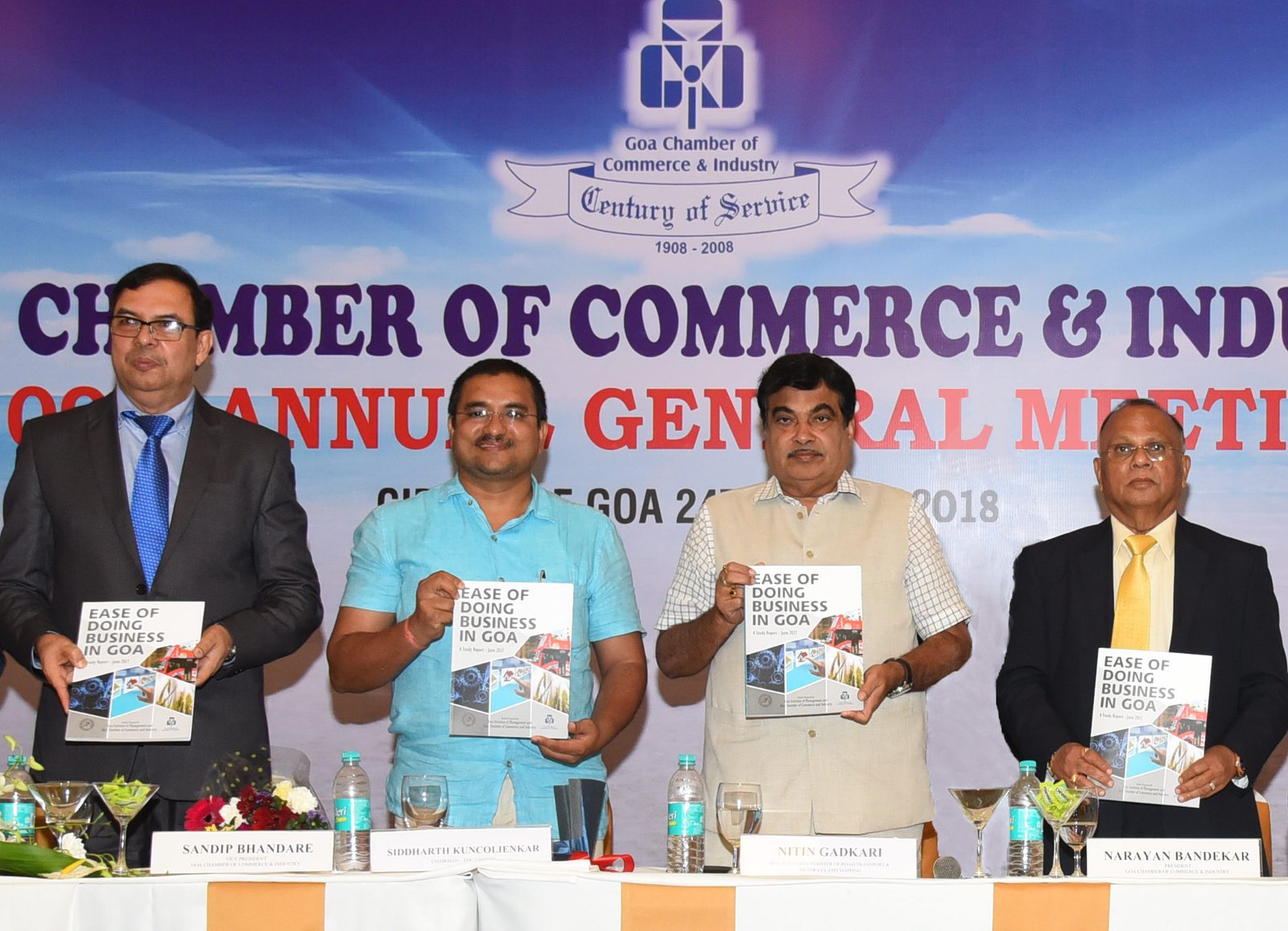
Goa performed better in the rankings this year. But there is a long way ahead to meet the spirit of EoDB writes Dr Manoj Kamat
The first half of the last month saw the World Bank and the Department of Industrial Policy and Promotion (DIPP), Government of India release the ‘Ease of Doing Business’ Index (EoDB) for the Indian States. Goa has climbed two places in the rankings of States in the EoDB to move forward two slots from 21st to 19th position. The implementation of reforms has been the key focus of the rankings this year based on 78 out of 372 reforms implemented last year and public feedback being taken on the same. In the past, rankings were based only on reforms undertaken by the states and no feedback was taken. The State of Andhra Pradesh has once again received top honours with a combined score of 98.30% followed by Telangana at a wafer thin difference having an average of 98.28%. Haryana (98.06%), Jharkhand (98.05%), Gujarat (97.99%) and Chhattisgarh (97.31%) followed in the EoDB rankings. The degree of competition in the top echelons can be observed from the fact that the difference in score between the first scorer and seventh-placed Madhya Pradesh (97.3%) was just 1.00 points. The EoDB as the title indicates refers to how friendly and conducive a place can be for somebody looking to set up a business activity. Performance in this index is expected to be a key factor in helping market their state as a profitable investment destination.
The ‘Ease of Doing Business’ index (EoDB) initiative is curated by World Bank (WB) and the Department of Industrial Policy and Promotion, Govt of India for the Indian States. It offers rankings among the States based on the potential to attract business and undertake various reforms that are being undertaken by the Centre. This is also an indicative list that is assumed to help prospective investors and entrepreneurs, targeting India besides creating a healthy competition among States to improve their bargaining capacity when it comes to attracting big-ticket investments. This year’s EoDB survey was different from the fact that it has given weightage to actual ground reports through feedbacks from the private sector and industry to see what reforms have actually translated into. Implementation of reform has been the key focus and based on 78 out of 372 reforms last year, the public feedback was solicited. The sample was almost 9000 people to get the users of the reforms from all the states numbering more than 50000, out of which more than 5000 users were randomly selected to speak to them. Many states did not send any user data, so the feedback could be run only in 23 states.

The Goa Chamber of Commerce has expressed its happiness that Goa fared comparatively well compared to its performance in the previous year. The rank Goa received last year was a great shocker to the industry and much below the relative expectations of many stakeholders. On a corrective note, the GCCI soon commissioned the Goa Institute of Management (GIM) to conduct a study to identify the areas of improvement. Accordingly, a number of action areas were identified and a detailed report was submitted to the Chief Minister at the last AGM of GCCI.
The State of Goa was able to implement 222 (combined average of 57.34%) reform agenda points out of the 372 mandated. Goa failed to implement 139 points, while 11 action points for reforms were not applicable for the state. Out of these 11 points not relevant, Goa needs around 6 action points pertaining to the designing of e-systems for the Inspectorate of Factories and Boilers. Since the number of applicants for boiler erector and number of approvals granted in the State of Goa have been less than 10 in the last five years from 2013 to 2017, exemption has been sought for the implementation of the 6 aforementioned recommendations. Similarly, Goa was also required to design and implement a GIS system to provide details about the land earmarked for industrial use across the State along with the design of GIS system providing details about available infrastructure such as road, water, electrical substation and poles, proximity to National/State highways, Railway lines etc. for all industrial land banks of Goa. This recommendation too could not be complied with as IDC at present, does not have the land available for industrial use and thus details with respect to infrastructure for all industrial land in the State of Goa does not arise.
The parameters where Goa scored well on the ‘Reforms Evidence Score’ were ‘better construction permit enablers’ with a score of 55 (Andhra Pradesh scored 91) and for enabling ‘better access to information and transparency’ with a score of 32 (Andhra Pradesh scored 53). We were significant laggards in the areas of ‘enabling environment registration’ with a score of around 9, ‘provision of single window services’ and in ‘availability of land’ with scores of 6 each. Goa’s score percentage on the ‘Reforms Evidence’ is 5.5067 as against 33.7346 scored by top ranking State of Andhra Pradesh.
Underperformance of States
The current rankings for the first-time factored in user-feedback on the quality of implementation of the reforms claimed by the States on 12 parameters namely, construction permits, labour regulation, environmental registrations, information access, land availability, paying taxes, and single window system among others. State governments promise a number of reforms but some of these remain only on paper. The industry feedback from businesses, lawyers, architects and electrical contractors was an attempt to capture the practicality of the reforms put on paper. To Goa’s greatest credit the Business Reforms Action Plan (BRAP), which had stood at 18 percent last year has now taken a big leap forward to 57.34 percent. This shows that there has been a sizeable increase in Goa implementing the reform agenda. But this is far from enough. Compared to Goa’s dismal performance, the BRAP score of all the States in the top ten brackets is above 90 percent.

The new scheme that included industry feedback brought to light glaring discrepancies in reforms and their actual implementation. An actual comparison of the reform scores and feedback shows why some states surprise on the EODB rankings. Goa scored a mere 14.12% based on the ‘feedback’ score taking the difference to starling to 46.88%, a substantial indication that the reforms initiated do not reflect ground realities. The report has thrown up surprising results with Maharashtra, often touted as India’s most industrialised state led by the bustling financial capital of Mumbai, ranked 13th with a reform evidence score of 97.29 percent but a “feedback score” of 50.29%. Similarly, despite being an industrial hub, the southernmost state Tamil Nadu clocked 15th rank, with a “reform evidence score” of 95.93 percent and a feedback score of 43.90%. For Delhi, the discrepancy between actual and paper reforms is even more glaring, 33.99% on paper but just 6.4% through industry feedback. Delhi’s rank slipped to 23rd this time from 19th in 2016 and 15th in 2015. Andhra Pradesh scored 99.73% on reforms and 86.5% on feedback, while for Telangana the corresponding figures were 100% and 83.95%, respectively. All the North Eastern states and Chandigarh had a zero on feedback rating; Delhi was just above Kerala which had a dismal 1.97% feedback rating. Gujarat has raised a grievance that despite having a higher feedback score of 83.64 percent as compared to Haryana (82.9 percent) and same reform evidence score (99.73 percent), the state was placed two notches lower. Although two states, Telangana and Jharkhand have implemented 100% of the reforms, Andhra Pradesh gained a higher overall score. Mizoram, Andaman, Manipur and Sikkim undertook less than 4% of reforms that were listed by the DIPP, whereas the States like Arunachal Pradesh, Lakshadweep and Meghalaya (ranked last) did not undertake even a single reform.
The rank Goa received last year was a great shocker to the industry and much below the relative expectations of many stakeholders. On a corrective note, the GCCI soon commissioned the Goa Institute of Management (GIM) to conduct a study to identify the areas of improvement. Accordingly, a number of action areas were identified and a detailed report was submitted to the Chief Minister by GCCI
Andhra Pradesh performed to top the EoDB rankings much to the success of an initiative called ‘Andhra Public Service Guarantee Act 2017’ which guarantees a time-bound dispensation of more than 60 services. These include providing electricity connections, environmental clearances etc. in the promised time or else the defaulting officer is penalised through salary deductions. Today, the State claims that more than 99% applications for starting a business are cleared in the stipulated time.
Goa Chamber of Commerce took it as a mission to improve the state’s ranking: Sandip Bhandare

Goa has bagged the 19th rank overall and the 1st Rank among the aspiring states in the last ranking of the states for Ease of Doing Business. While in terms of rank, our position has improved only by two ranks – from 21st to 19th, in terms of the score, we have shown substantial improvement from around 19% to 57%. This is really praiseworthy.
When we received the ranking of the last year, the GCCI took it as a mission that we will make all efforts to co-operate with the Government to improve the rank. We commissioned a study by engaging Goa Institute of Management and prepared a report giving very useful suggestions on the ‘low hanging fruits’ as well as medium term and long term goals.
I am happy that Goa has improved its ranking as well as score. However I am aware of the fact that as compared to the top 10 states, we are lagging far behind and a lot more needs to be done. Further, the ranking is like an examination. While the examination is important, the education and knowledge is far more important. We have to thus ensure that we not only improve our scoring and rank but also the actual situation on the ground level. The Investment Promotion Board with its new CEO, unfreezing of SEZ Land, digitization of the Government functioning will, I am sure, go a long way in improving the Ease of Doing Business and Goa should hopefully be among the first 10 states in the coming years.
The other much talked index is the Ease of Doing Business published by the World Bank as part of its ‘Doing Business Report’. This report is primarily a benchmark study of regulations. This index ranks countries, unlike the EoDB rank of Indian States. The better performance of Indian States in the EoDB including that of Goa will go a long way in improving the performance of our country on EoDB rankings, as the effect of improving State regulations on economic growth of the country as a whole is claimed to be very strong. Moving from the worst one-fourth of nations to the best one-fourth implies a 2.3 percentage point increase in annual GDP rate. The EoDB index is an aggregate figure that includes different parameters which define the ease of doing business in a country. In the last EoDB rankings by the World Bank, India jumped 30 ranks to secure the 100th position as per report released in November 2017 in an endorsement of a string of reforms implemented. India has truly done lots of reforms based on the World Bank report of the last year. India has submitted the claims and the World Bank team have visited the country already. The process of feedback is on and results will be out in October. India seems most likely to emerge as a relative winner again in the EoDB rankings that are expected shortly.
Ranking caveats
The current ranking system is not free from caveats either. The EoDB rankings promote competition among States to create a conducive investment climate, and it is thus fair to say that the EoDB rankings do not necessarily mean there will be high investments in states which top this chart, the rankings are mere enablers. Secondly, although the idea behind ranking states is to induce competition in attracting investments and to improve the business climate, practically the assumption is not proved. Rankings have not always translated into investments. The ranking is not reflective of the total investments various States are able to solicit. For instance Karnataka ranked eighth in 2017 against 13th in 2016, but received the most number of investment proposals amounting almost 40% of the country’s total investment proposal value of ₹1.9 lakh crore between January and May this year. However, Haryana, which improved its ranking in ease of doing business from 14th in 2016 to third now, hardly attracted any investments of just 0.2% of India’s total investment proposal value between January and May. Thirdly, some States get higher investments irrespective of its rankings on EoDB scale. The manufacturers take investment decisions after considering several other parameters like a ready market for their products, office location, land availability etc. and thus may find some States more attractive anyways. For instance, Maharashtra has the best infrastructure for ancillaries, ports, roads, power and would draw high investment regardless of its EoDB rank. Maharashtra and Delhi remain the top contenders for foreign direct investment (FDI) in India, never mind their EoDB rankings being well below the toppers, Andhra Pradesh and Telangana. The same holds true for Gujarat and Tamil Nadu. Similarly, Bihar and Jharkhand get investments for mining irrespective of the environment as these are mineral-rich states, regardless of its investment-unfriendly environment. Further the rankings are more skewed towards new states which start from scratch and can introduce transparent policies, have fewer legacies, have online systems for execution and can take less time for compliance. Telangana and Jharkhand capitalised on this factor.
Govt. needs a focused approach: Pai Raiker

Chairman, MSME, ASSOCHAM
The government, in its wisdom, had formed a committee to work on the areas of concern to streamline the business investment in the state. However, we are yet to see the report given by the committee. There are lots of grey areas which need to be worked upon to bring the system in order. The policies formulated by the consultants do not seem to be working. Most of the other states which have surged forward have taken the views of those with established units and sufficient experience. The new generation entrepreneurs look for smooth process of the administrative system within the framework of existing framework of rules and regulations. There need to be proactive approach from the dealing hands of the Government in order to fulfill the promised phrases from the prevailing Industrial policy. There is also a need for proper handholding during the time of implementation of the establishment. Any investor takes care to see that his investment is in the safe area and that sufficient Government back-up and support is available. There is lot to learn from aggressive and proactive states like Andhra Pradesh, Telangana, Gujarat, Maharashtra etc.
Goa being a small state has lot of constraints within which the policy will have to be outlined. Ours is an eco-fragile state more dependent on tourism now. We need to project the state in the right way. We have to define which industry is welcome; and the one in the negative list need not be entertained at all. Investors will appreciate this and also think positively about stepping in. The infrastructure has to be ready and available without delay. The major parameters of Ease of Doing Business are within the domain of the Government and can be easily streamlined. In the year 2013, we had worked upon this area with the co-operation of the then secretary of Industries. It did not see the light of the day. Rather, more and more consultants stepped in with very little success. Time is not lost yet and the Government needs to act with a focused approach and change the dynamics of process and procedures. Our youth are expectantly looking forward for the opportunities without hurdles.
Notwithstanding the fact that the ranking process has caveats and rankings don’t guarantee investments, the importance of scoring higher on these rankings cannot be underplayed with. The State of Goa has underperformed, and underperformed grossly. The practioneers hardly saw reforms implemented on the floor. Corruption and delays are still persistent in getting power connection sanctioned and for obtaining higher loads. The Investment Promotion Board could not find for itself a CEO for almost a year. It is reported that the new CEO has been appointed recently, after the post remained vacant from September last year. The Goa IPB meetings are not frequented and there is no vibrant machinery to follow-up the decisions. Recently the Promotion Board ‘re-evaluated’ the approvals granted for two Marinas, at Nauxi and Sancoale that were granted approval almost three years back, in April 2015. The Goa IDC still falls short on completing the required formalities and sanctioning land to the cases referred to it. No private land banks are notified. Goa’s MSME sector is yet to rise after the GST blow. Public sector banks have fallen short of lending to business. The newly launched Start-up scheme is yet to show the early inspiring trends. The Power Minister, who is reportedly unwell, has left his department incapacitated. The Chief Minister is caught up in myriad of other important things, leaving him with little time and energy for the vital portfolio of Industries that he holds, while it looks like the ‘deficit’ of trust’ makes it difficult for him to decentralise decision making. In October 2017, addressing the ELETS Knowledge Exchange Conference, the Chief Minister had promised that Goa would rank among the top three states in the country in EODB by 2019. We have more 16 States to compete with and hardly a year remaining





